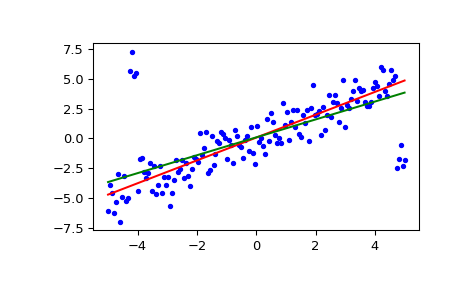siegelslopes#
- scipy.stats.siegelslopes(y, x=None, method='hierarchical')[源代码][源代码]#
计算一组点 (x, y) 的 Siegel 估计量。
siegelslopes实现了一种使用重复中位数(参见 [1])进行稳健线性回归的方法,以拟合点 (x, y) 的直线。该方法对异常值具有 50% 的渐近崩溃点。- 参数:
- yarray_like
因变量。
- x类似数组或无,可选
自变量。如果为 None,则使用
arange(len(y))代替。- 方法{‘层次结构’, ‘分离’}
如果为 ‘hierarchical’,使用估计的斜率
slope来估计截距(默认选项)。如果为 ‘separate’,则独立于估计的斜率来估计截距。详见注释。
- 返回:
- 结果 :
SiegelslopesResult实例SiegelslopesResult 实例 返回值是一个具有以下属性的对象:
- 斜率浮动
回归线的斜率估计。
- 拦截浮动
回归线的截距估计值。
- 结果 :
参见
theilslopes一种类似的技术,无需重复中位数
注释
设
n = len(y),计算m_j为从点(x[j], y[j])到所有其他 n-1 个点的斜率的中位数。slope则是所有斜率m_j的中位数。在 [1] 中给出了两种估计截距的方法,可以通过参数method选择。层次化方法使用估计的斜率slope,并将intercept计算为y - slope*x的中位数。另一种方法单独估计截距,如下所示:对于每个点(x[j], y[j]),计算通过剩余点的所有 n-1 条线的截距,并取中位数i_j。intercept是所有i_j的中位数。该实现计算了大小为 n 的向量的 n 次中位数,这对于大型向量来说可能会很慢。有更高效的算法(参见 [2]),但这里没有实现。
为了与旧版本的 SciPy 兼容,返回值的行为类似于长度为 2 的
namedtuple,具有slope和intercept字段,因此可以继续编写:slope, intercept = siegelslopes(y, x)
参考文献
[1] (1,2)A. Siegel, “Robust Regression Using Repeated Medians”, Biometrika, Vol. 69, pp. 242-244, 1982.
[2]A. Stein and M. Werman, “Finding the repeated median regression line”, Proceedings of the Third Annual ACM-SIAM Symposium on Discrete Algorithms, pp. 409-413, 1992.
示例
>>> import numpy as np >>> from scipy import stats >>> import matplotlib.pyplot as plt
>>> x = np.linspace(-5, 5, num=150) >>> y = x + np.random.normal(size=x.size) >>> y[11:15] += 10 # add outliers >>> y[-5:] -= 7
计算斜率和截距。为了比较,也使用
linregress计算最小二乘拟合:>>> res = stats.siegelslopes(y, x) >>> lsq_res = stats.linregress(x, y)
绘制结果。Siegel回归线以红色显示。绿色线显示了用于比较的最小二乘拟合。
>>> fig = plt.figure() >>> ax = fig.add_subplot(111) >>> ax.plot(x, y, 'b.') >>> ax.plot(x, res[1] + res[0] * x, 'r-') >>> ax.plot(x, lsq_res[1] + lsq_res[0] * x, 'g-') >>> plt.show()
